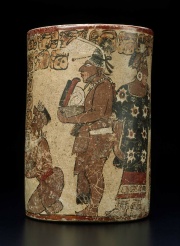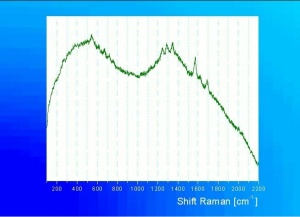Difference between revisions of "Maya blue"
Jump to navigation
Jump to search
| Line 17: | Line 17: | ||
== Physical and Chemical Properties == | == Physical and Chemical Properties == | ||
| − | Fibrous or platy particles are pleochroic (turquoise blue to yellow-green). Weak birefringence under crossed polars. | + | * Fibrous or platy particles are pleochroic (turquoise blue to yellow-green). |
| − | + | * Weak birefringence under crossed polars. | |
| − | Unaffected by alkalies. Soluble in hot concentrated acids. | + | * Unaffected by alkalies. Soluble in hot concentrated acids. |
| − | + | * Refractive Index = 1.522-1.548 | |
| − | Refractive Index = 1.522-1.548 | ||
== Comparisons == | == Comparisons == | ||
| Line 28: | Line 27: | ||
== Resources and Citations == | == Resources and Citations == | ||
| + | * Ruth Siddall, 'Mineral Pigments in Archaeology: Their Analysis and the Range of Available Materials' ''Minerals'' Vol 8, p. 201 (2018). [https://www.academia.edu/36588315/Mineral_Pigments_in_Archaeology_Their_Analysis_and_the_Range_of_Available_Materials?email_work_card=view-paper Link] | ||
* R.Kleber, L.Masschelein-Kleiner, J.Thissen, "Etude et Identification du Bleu Maya" ''Studies in Conservation'', 33: p.41-56, 1967. | * R.Kleber, L.Masschelein-Kleiner, J.Thissen, "Etude et Identification du Bleu Maya" ''Studies in Conservation'', 33: p.41-56, 1967. | ||
* L.Torres, "Maya Blue: How the Mayas Could have Made the Pigment" Materials Research Society Symposium Proceedings, 123: p. 123-129, 1988. | * L.Torres, "Maya Blue: How the Mayas Could have Made the Pigment" Materials Research Society Symposium Proceedings, 123: p. 123-129, 1988. | ||
* Nicholas Eastaugh, Valentine Walsh, Tracey Chaplin, Ruth Siddall, ''Pigment Compendium'', Elsevier Butterworth-Heinemann, Oxford, 2004 | * Nicholas Eastaugh, Valentine Walsh, Tracey Chaplin, Ruth Siddall, ''Pigment Compendium'', Elsevier Butterworth-Heinemann, Oxford, 2004 | ||
| − | |||
* ''Artists' Pigments: A Handbook of their History and Characteristics'', Elisabeth West FitzHugh, Oxford University Press, Oxford, Vol. 3, 1997 Comment: H.Schweppe, "Indigo and Woad" | * ''Artists' Pigments: A Handbook of their History and Characteristics'', Elisabeth West FitzHugh, Oxford University Press, Oxford, Vol. 3, 1997 Comment: H.Schweppe, "Indigo and Woad" | ||
| − | |||
* R. J. Gettens, G.L. Stout, ''Painting Materials, A Short Encyclopaedia'', Dover Publications, New York, 1966 | * R. J. Gettens, G.L. Stout, ''Painting Materials, A Short Encyclopaedia'', Dover Publications, New York, 1966 | ||
| − | |||
* Ralph Mayer, ''A Dictionary of Art Terms and Techniques'', Harper and Row Publishers, New York, 1969 (also 1945 printing) | * Ralph Mayer, ''A Dictionary of Art Terms and Techniques'', Harper and Row Publishers, New York, 1969 (also 1945 printing) | ||
| − | |||
* Random House, ''Webster's Encyclopedic Unabridged Dictionary of the English Language'', Grammercy Book, New York, 1997 | * Random House, ''Webster's Encyclopedic Unabridged Dictionary of the English Language'', Grammercy Book, New York, 1997 | ||
| − | |||
* ''The American Heritage Dictionary'' or ''Encarta'', via Microsoft Bookshelf 98, Microsoft Corp., 1998 | * ''The American Heritage Dictionary'' or ''Encarta'', via Microsoft Bookshelf 98, Microsoft Corp., 1998 | ||
| − | + | * Art and Architecture Thesaurus Online, https://www.getty.edu/research/tools/vocabulary/aat/, J. Paul Getty Trust, Los Angeles, 2000 | |
| − | * Art and Architecture Thesaurus Online, | ||
[[Category:Materials database]] | [[Category:Materials database]] | ||
Revision as of 13:37, 28 February 2024
Description
A greenish-blue pigment found on wall paintings and painted objects from several Maya sites. After many years of study, it was determined in 1967 that Maya blue is composed of Indigo absorbed on a clay substrate (Kleber et al., 1967). Palygorskite (Attapulgite), Montmorillonite and Sepiolite clays were used (Torres 1988).
Synonyms and Related Terms
Mayan blue (sp); bleu maya (Fr.); Mayablau (Deut.); azul maya (Esp.); azul de Maya (Esp., Mex.); mple ton Magia (Gr.); blu Maya (It.); Maya blauw (Ned.); azul Maia (Port.)
Possible synonyms: Canutillow blue; Tekax blue; texotli (Mex.)
Risks
No significant hazards.
Physical and Chemical Properties
- Fibrous or platy particles are pleochroic (turquoise blue to yellow-green).
- Weak birefringence under crossed polars.
- Unaffected by alkalies. Soluble in hot concentrated acids.
- Refractive Index = 1.522-1.548
Comparisons
Characteristics of Common Blue Pigments
Resources and Citations
- Ruth Siddall, 'Mineral Pigments in Archaeology: Their Analysis and the Range of Available Materials' Minerals Vol 8, p. 201 (2018). Link
- R.Kleber, L.Masschelein-Kleiner, J.Thissen, "Etude et Identification du Bleu Maya" Studies in Conservation, 33: p.41-56, 1967.
- L.Torres, "Maya Blue: How the Mayas Could have Made the Pigment" Materials Research Society Symposium Proceedings, 123: p. 123-129, 1988.
- Nicholas Eastaugh, Valentine Walsh, Tracey Chaplin, Ruth Siddall, Pigment Compendium, Elsevier Butterworth-Heinemann, Oxford, 2004
- Artists' Pigments: A Handbook of their History and Characteristics, Elisabeth West FitzHugh, Oxford University Press, Oxford, Vol. 3, 1997 Comment: H.Schweppe, "Indigo and Woad"
- R. J. Gettens, G.L. Stout, Painting Materials, A Short Encyclopaedia, Dover Publications, New York, 1966
- Ralph Mayer, A Dictionary of Art Terms and Techniques, Harper and Row Publishers, New York, 1969 (also 1945 printing)
- Random House, Webster's Encyclopedic Unabridged Dictionary of the English Language, Grammercy Book, New York, 1997
- The American Heritage Dictionary or Encarta, via Microsoft Bookshelf 98, Microsoft Corp., 1998
- Art and Architecture Thesaurus Online, https://www.getty.edu/research/tools/vocabulary/aat/, J. Paul Getty Trust, Los Angeles, 2000

